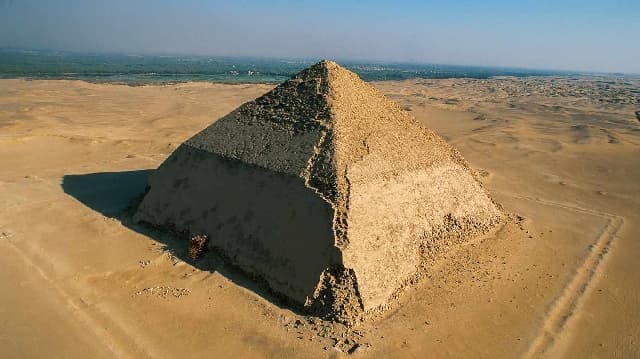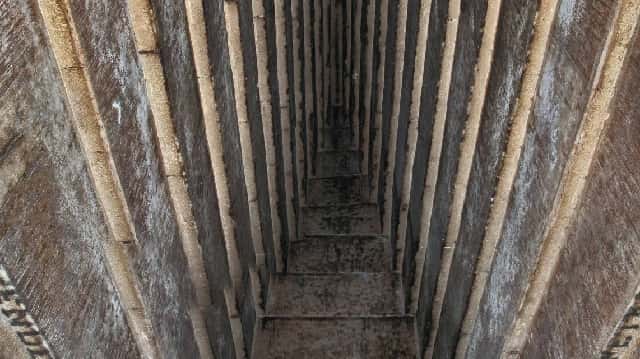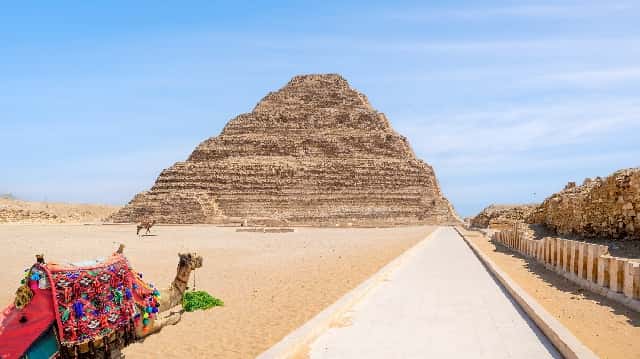

Explore the Red Pyramid—Sneferu’s grand design that paved the way for Giza. Quietly majestic near Cairo.
1- Towering Legacy of the Red Pyramid
2- What Makes the Red Pyramid Unique
3- Architectural Features and Interior Layout
4- The Mystery of the Pyramidion
5- The Visitor Experience
6- Exploring Dahshur: Other Pyramids and Attractions
7- Conclusion: The Legacy of the Red Pyramid of Dahshur
8- FAQs
Standing 105 meters tall in Dahshur, the Red Pyramid is Egypt’s first true smooth-sided pyramid and a blueprint for Giza’s later marvels. Built by Pharaoh Sneferu around 2590 BCE, it once gleamed with white Tura limestone, now long gone. Despite the passage of time, its structure—housing three chambers and a striking 12-meter corbelled roof—remains impressively intact. This overlooked gem, Egypt’s third-largest pyramid, continues to intrigue with its enduring mystery and architectural brilliance.
Around 2590 BCE, Pharaoh Sneferu of Egypt’s 4th Dynasty commissioned the Red Pyramid—his third and most perfected monument. It set the standard for all later true pyramids.
Following engineering challenges with earlier projects, Sneferu ordered this pyramid as his grand tomb. Though human remains were found inside, it’s still debated whether he was actually buried there. The monument, either way, immortalized his legacy and launched Egypt’s golden age of pyramid construction.
Construction likely began in Sneferu’s 30th year. While the exact timeline is debated—estimates range from 10 to 17 years—the result endures in Dahshur’s royal necropolis, about 25 km south of Cairo and just a kilometer north of his Bent Pyramid.
Amid Egypt’s timeless desert wonders, the Red Pyramid at Dahshur stands out as a revolutionary feat in ancient architecture—praised by scholars for changing pyramid design forever.
The Red Pyramid holds the title of the world’s first successful smooth-sided pyramid—a major leap from earlier step pyramids. Built at a precise 43-degree angle, its stable design corrected the flaws of the nearby Bent Pyramid and laid the foundation for the iconic pyramids at Giza.
Its reddish hue comes from the local limestone core, now exposed after medieval builders stripped away the gleaming white Tura casing stones to build Cairo. Originally known as "Re Du Mont" in honor of the sun god Re, today’s name reflects the raw, weathered beauty revealed by time.

The Red Pyramid rises as a marvel of ancient engineering—its clean geometry, towering scale, and hidden chambers reflecting a mastery that still astonishes today.
Standing 105 meters tall with a 220-meter base, the pyramid’s precise 43° angle ensured long-term stability. Built from around 2 million tons of stone in 160 layered courses, its gentle slope corrected past mistakes and set the gold standard for pyramid construction.
Though it appears reddish now, the pyramid was once sheathed in dazzling white Tura limestone. Most of that brilliant casing was stripped in the Middle Ages to build Cairo, but a few stones remain—some etched with Sneferu’s name and ancient crew marks.
Inside, three chambers reveal ingenious design. The first and second, aligned north-south, feature soaring corbelled ceilings. The final chamber, aligned east-west, may reflect afterlife beliefs. Its ceiling reaches 50 feet high, and its floor still bears scars from ancient looters.
A reconstructed pyramidion lies nearby, crafted from white Tura limestone—but its slope doesn’t match the pyramid’s, leaving scholars to wonder if it was truly meant for this tomb or another of Sneferu’s grand visions. Like much of ancient Egypt, it remains an unsolved riddle.
The Red Pyramid stands in Dahshur, a tranquil royal necropolis 40 km south of Cairo and part of the Memphis UNESCO World Heritage Site. Its location near the Nile and ancient Memphis made it ideal for royal burials. Today, it offers a peaceful, easily accessible escape from Cairo’s crowds.
Built as Pharaoh Sneferu’s tomb, the Red Pyramid symbolized his divine status and journey to the afterlife. Aligned with celestial points, it reflected deep religious and astronomical knowledge, while also showcasing the centralized power of his reign.

The Red Pyramid offers a quiet, immersive escape into ancient Egypt—without the crowds. Visitors climb to an elevated entrance, then descend a steep, narrow passage into cool, echoing chambers. Though unadorned, the pyramid’s precision engineering and atmosphere leave a lasting impression.
Located in Dahshur, about 25 km south of Cairo, the Red Pyramid sits near the Bent Pyramid and is accessible via a 2.5 km path from the ticket office.
Open daily from 8 AM to 5 PM in summer (until 4 PM in winter). Entry costs 100–200 EGP (50–100 for students) and involves a 125-step climb to the entrance.
Visit early to avoid heat and crowds. Wear comfortable shoes, bring water, and be prepared for tight spaces and steep passages. A guide can enrich the experience, but the visit is memorable either way.
Dahshur shines as one corner of a remarkable triangle of ancient Egyptian marvels:
Memphis — once the vibrant capital, now an open-air museum where towering statues echo the glory of a lost empire.
Saqqara — home to Djoser’s pioneering Step Pyramid, the bold ancestor of all that followed.
Adventurous travelers can visit all three in a single day, though fully appreciating their grandeur takes time. A popular itinerary follows history’s timeline: start at Dahshur (9–11 AM), then Memphis (11–12 PM), and conclude at Saqqara (12–1 PM), tracing the evolution of pyramid design from daring beginnings to architectural mastery.
Dahshur rewards thoughtful planning with solitude and historical depth. Just outside Cairo, it's a destination best explored with some logistics in mind.
Metro + Taxi: Budget travelers can combine Line 1 of Cairo’s metro with a local taxi for a trip costing just €1–3 and taking about 1 hour and 20 minutes.
Private Car or Taxi: For a faster, more comfortable ride, book a direct trip—roughly 40–45 minutes from the city center.
Uber: For hassle-free travel, Uber offers set fares and reliable service across Cairo.
Pro tip: Arrange round-trip transport, as return options from Dahshur are limited.

The Red Pyramid marks a turning point in ancient Egyptian architecture—Sneferu’s bold leap toward the smooth-sided form later perfected at Giza. As a symbol of innovation and ambition, it continues to captivate visitors with its historical importance and quiet grandeur. For those seeking a deeper connection to Egypt’s past, Dahshur offers a powerful, uncrowded window into a civilization that forever changed the world.
The Red Pyramid was constructed by Pharaoh Sneferu during the Old Kingdom of Egypt (2575–2551 BCE), which is known as the third pyramid attributed to him
During the Old Kingdom of Egypt (2575–2551 BCE)
The Red Pyramid was built as a tomb for a pharaoh, most likely Pharaoh Sneferu himself.
It’s Egypt’s first true smooth-sided pyramid, a breakthrough in ancient engineering that influenced all later designs.
Climb a staircase to the entrance, then descend a long, narrow tunnel in a crouched position.
October to April is ideal. Weekday mornings are quietest—avoid holidays and Ramadan.
At 105 meters tall, it’s the third largest pyramid in Egypt after Khufu and Khafre’s at Giza.
Comfortable shoes, water, sun protection, and lightweight clothing are essential.
Experience the Red Pyramid of Dahshur—Egypt’s first successful smooth-sided pyramid and an awe-inspiring chapter in ancient engineering.
